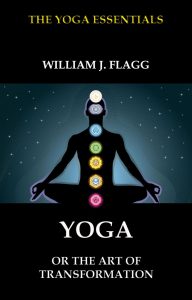Yoga or the Art of Transformation – William J. Flagg
A comparative statement of the various religious dogmas concerning the soul and its destiny, and of Akkadian, Hindu, Taoist, Egyptian, Hebrew, Greek, Christian, Mohammedan, Japanese and other magic. Thirty chapters deal with topics like
Modern Spiritualism On The Soul
Hindu Souls
Egyptian Souls
Chaldean Souls
Greek And Roman Souls
Neoplatonism On The Soul
Christian Souls
Relic Worship
Chinese Souls
Japanese Souls
The Possibility Of A Spiritual World Considered
Religion In General
The Evolution Of Social Virtue
Hindu Yoga
Chinese Yoga
Egyptian Yoga
Akkadian Yoga
Mohammedan Yoga
Hebrew Yoga
Yoga Of The Essenes
… and many more …
Format: Paperback.
Yoga or the Art of Transformation.
ISBN: 9783849699529
Available at amazon.com and other venues.
The definition of Yoga (from Wikipedia):
Yoga (/ˈjoʊɡə/; Sanskrit, योग Listen) is a group of physical, mental, and spiritual practices or disciplines which originated in ancient India. There is a broad variety of Yoga schools, practices, and goals in Hinduism, Buddhism, and Jainism. Among the most well-known types of yoga are Hatha yoga and Rāja yoga.
The origins of yoga have been speculated to date back to pre-Vedic Indian traditions, it is mentioned in the Rigveda, but most likely developed around the sixth and fifth centuries BCE, in ancient India’s ascetic and śramaṇa movements. The chronology of earliest texts describing yoga-practices is unclear, varyingly credited to Hindu Upanishads. The Yoga Sutras of Patanjali date from the first half of the 1st millennium CE, but only gained prominence in the West in the 20th century. Hatha yoga texts emerged around the 11th century with origins in tantra.
Yoga gurus from India later introduced yoga to the west, following the success of Swami Vivekananda in the late 19th and early 20th century. In the 1980s, yoga became popular as a system of physical exercise across the Western world. Yoga in Indian traditions, however, is more than physical exercise; it has a meditative and spiritual core. One of the six major orthodox schools of Hinduism is also called Yoga, which has its own epistemology and metaphysics, and is closely related to Hindu Samkhya philosophy.
Many studies have tried to determine the effectiveness of yoga as a complementary intervention for cancer, schizophrenia, asthma, and heart disease. The results of these studies have been mixed and inconclusive, with cancer studies suggesting none to unclear effectiveness, and others suggesting yoga may reduce risk factors and aid in a patient’s psychological healing process. On December 1, 2016, Yoga was listed as UNESCO’s Intangible cultural heritage.
(The text of the last section was taken from a Wikipedia entry and is available under the the Creative Commons Attribution-ShareAlike License.)
Publisher’s Note: This book is printed and distributed by Createspace a DBA of On-Demand Publishing LLC and is typically not available anywhere else than in stores owned and operated by Amazon or Createspace.

